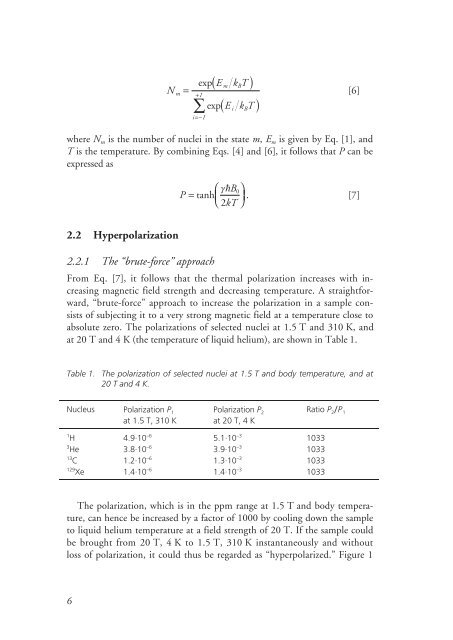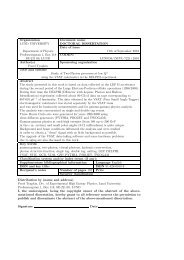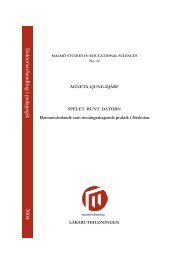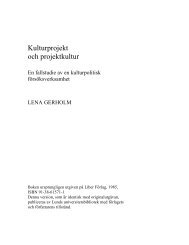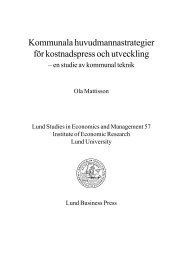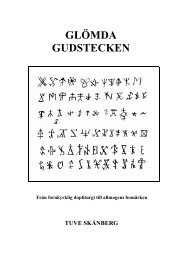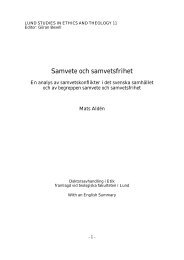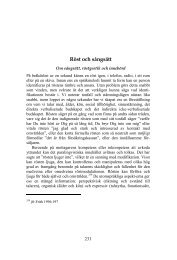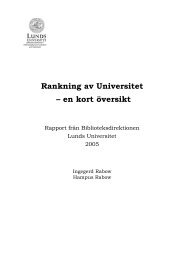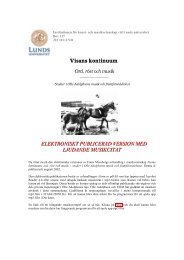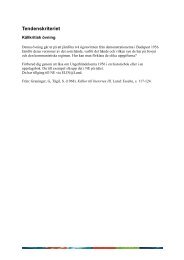Hyperpolarized Nuclei for NMR Imaging and Spectroscopy - Lunds ...
Hyperpolarized Nuclei for NMR Imaging and Spectroscopy - Lunds ...
Hyperpolarized Nuclei for NMR Imaging and Spectroscopy - Lunds ...
Create successful ePaper yourself
Turn your PDF publications into a flip-book with our unique Google optimized e-Paper software.
6<br />
N<br />
m<br />
=<br />
exp(<br />
Em kBT) + I<br />
exp(<br />
Ei kBT) ∑<br />
i=−I where N m is the number of nuclei in the state m, E m is given by Eq. [1], <strong>and</strong><br />
T is the temperature. By combining Eqs. [4] <strong>and</strong> [6], it follows that P can be<br />
expressed as<br />
2.2 Hyperpolarization<br />
P =<br />
2.2.1 The “brute-<strong>for</strong>ce” approach<br />
[6]<br />
⎛ B ⎞<br />
⎜ ⎟ . [7]<br />
⎝ 2kT<br />
⎠<br />
tanh γ h 0<br />
From Eq. [7], it follows that the thermal polarization increases with increasing<br />
magnetic field strength <strong>and</strong> decreasing temperature. A straight<strong>for</strong>ward,<br />
“brute-<strong>for</strong>ce” approach to increase the polarization in a sample consists<br />
of subjecting it to a very strong magnetic field at a temperature close to<br />
absolute zero. The polarizations of selected nuclei at 1.5 T <strong>and</strong> 310 K, <strong>and</strong><br />
at 20 T <strong>and</strong> 4 K (the temperature of liquid helium), are shown in Table 1.<br />
Table 1. The polarization of selected nuclei at 1.5 T <strong>and</strong> body temperature, <strong>and</strong> at<br />
20 T <strong>and</strong> 4 K.<br />
Nucleus Polarization P 1<br />
at 1.5 T, 310 K<br />
1 H 4.9·10 –6<br />
3 He 3.8·10 –6<br />
13 C 1.2·10 –6<br />
129 Xe 1.4·10 –6<br />
Polarization P 2<br />
at 20 T, 4 K<br />
5.1·10 –3<br />
3.9·10 –3<br />
1.3·10 –3<br />
1.4·10 –3<br />
Ratio P 2/P1<br />
1033<br />
1033<br />
1033<br />
1033<br />
The polarization, which is in the ppm range at 1.5 T <strong>and</strong> body temperature,<br />
can hence be increased by a factor of 1000 by cooling down the sample<br />
to liquid helium temperature at a field strength of 20 T. If the sample could<br />
be brought from 20 T, 4 K to 1.5 T, 310 K instantaneously <strong>and</strong> without<br />
loss of polarization, it could thus be regarded as “hyperpolarized.” Figure 1


